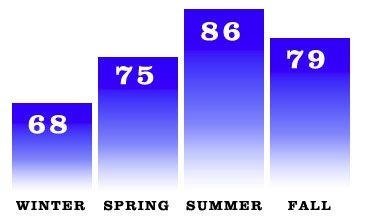Why Heat Your Pool?
Extend your swim season
A heated pool can double or even triple your comfortable swim season. The unfortunate reality is that a screened pool is only 80°F or warmer for about three months. Screened pools near the coast and in urban surroundings will be the warmest, possibly reaching 83–85°F between the last week of July through the first week in September.

Unheated Pool Temperature
Seasonal averages in degrees Fahrenheit Ft. Lauderdale, FL
Open pools are usually a few degrees warmer than screened pools because the pool surface receives more direct solar energy. An open pool may stay above 80°F for over four months.
With a fairly typical residential swimming pool, patio deck and screen enclosure now running between $25,000 and $40,000, it makes absolutely no sense if you are only able to enjoy your pool for three months of the year. Especially when Florida’s climate offers nine months or more of great outdoor weather.
Still, even if you never go near your pool during the winter, a pool heater can double and, in some cases, triple your comfortable swim season, by opening up those wonderful spring and fall days when the weather is beautiful but that pool is just too nippy.
Does it make sense to increase your pool investment by 10 to 15 percent if it allows you to get 200 to 300 percent more use and enjoyment out of your pool?
Where do we get our temperature information?
An unheated swimming pool’s water temperature will usually match the average air temperature for the preceding week. If the pool is warmer than the air after a cold front passes through, the pool will give up heat energy through evaporation until the air and water temperatures are the same.
Think of it this way: You run your air conditioner during the summer to cool your home. If you were to open all the doors and windows on a hot summer day, the indoor air temperature would rise to match the outdoor air temperature within a fairly short time. At some point, the indoor and outdoor air temperatures would be the same.
Your pool goes through the same balancing act, only in reverse.
So the unheated pool temperatures you see on the this page are the same as the 10-year average air temperatures for each three-month season at the latitude and longitude of the reference city.
Our data comes from 10 years of NASA weather data. Unlike measurements taken at an airport, the NASA data represent an average for an area measuring one degree of latitude by one degree of longitude. Naturally, actual temperatures within this area will vary: a bit warmer in urban surroundings and a bit cooler in rural surroundings
